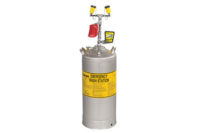
Non-compliance with emergency eyewash safety standards is a serious issue in today’s workplace. According to the National Institute for Occupational Safety and Health (NIOSH), this lack of compliance contributes to a reported 2,000 injured U.S. workers each day. In fact, the U.S. Bureau of Labor Statistics (BLS) reports that eye injuries lead to 37,000 missed days of work and more than $300 million per year in related costs.
Part of the problem is that many companies simply do not understand the need for emergency eyewash stations in their facilities. Employers need to be proactive and take the proper steps to ensure compliance before an accident occurs. Compliance begins with proper understanding of the regulations.
Do you know what is necessary to meet the ANSI Z358.1-2004 standard? Take this eyewash quiz to see if you know what it takes to be compliant.
|
||||||||||||
|
||||||||||||
|
||||||||||||
|
||||||||||||
|
||||||||||||
|
||||||||||||
|
||||||||||||
|
||||||||||||
|
||||||||||||
|
||||||||||||
Finding help
How did you score? Hopefully you got 100 percent correct and, therefore, have a facility that is in total compliance. However, the reality is that many facilities are not 100 percent correct when it comes to meeting guidelines for emergency eyewash stations. Don’t worry; there is plenty of help available to get you compliant quickly. For instance:American National Standards Institute (www.ansi.org) offers:
- eStandards Store, http://webstore.ansi.org/ansidocstore/default.asp
- ANSI Subscriptions, http://webstore.ansi.org/ansidocstore/subscriptions/subscriptionhome.asp
OSHA (www.osha.gov) offers helpful reference information and materials.
So, while there is a lot to know and do to meet the ANSI Z358.1-2004 standard, many resources are available to help. The equipment manufacturer, distributor, ISEA, ANSI and OSHA all want to help make sure that you and your workers are protected. Be sure your company meets the latest standards to minimize eye injuries and avoid financial hardship from noncompliance.





